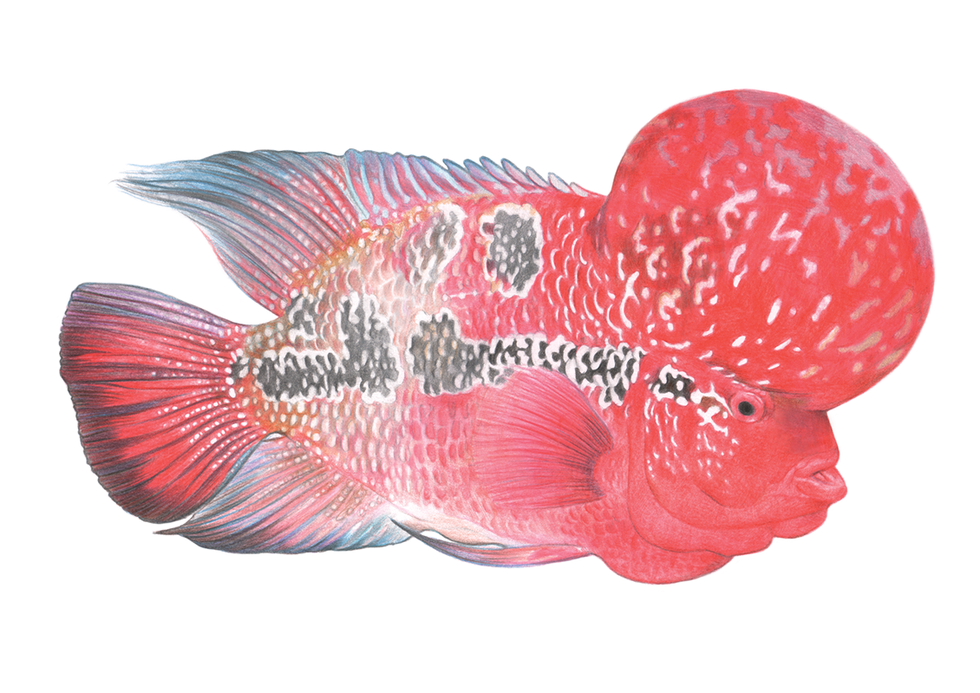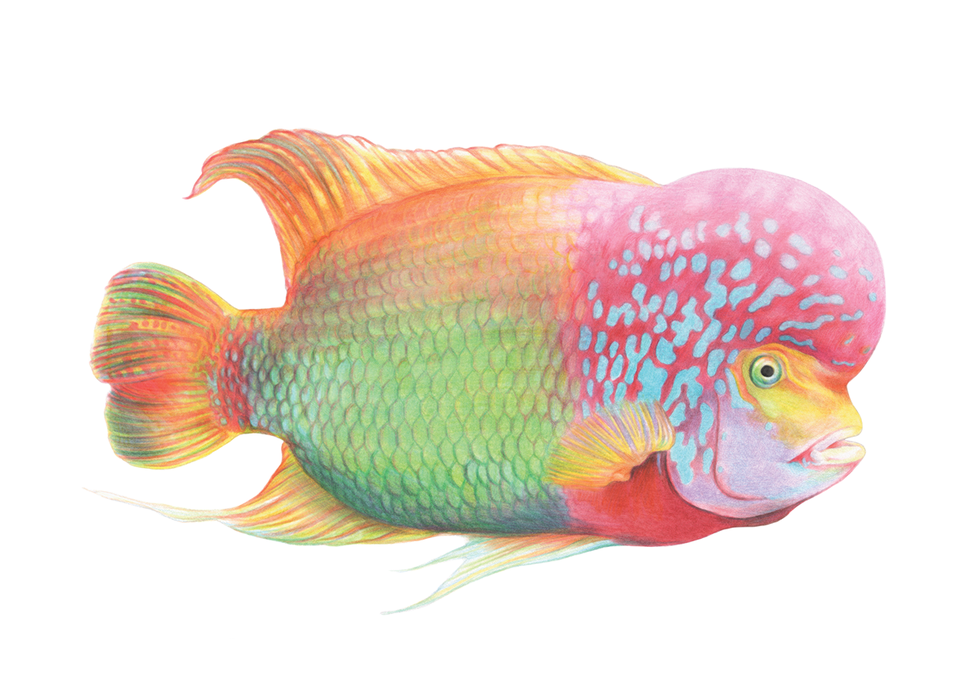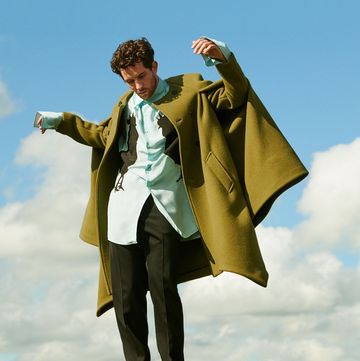On what was to become the momentous day in February 2017 when he visited One Fish, Two Fish, his local aquatics store in Dartmouth, Nova Scotia, though it was in fact an hour away from his home in Truro, Joey Mullen had sworn off making any impulse purchases. He’d gone to take a look around, pick up a few nerite snails and some otocinclus catfish and a pearl stingray he’d had his eye on, and to film a tour of the store for his YouTube channel on which Mullen goes by the name “The King of DIY”. But something about this particular fish, in a tank by himself, made him stop. It was a young flowerhorn cichlid, around six months old and three inches long. It seemed to be looking right at him. When he put his finger to the glass the fish followed it, looping and doubling back, even doing back-flips. “He’s just loving you,” said the store manager. “I think he wants to come home,” said Mullen.
Mullen knew better than most what he was letting himself in for. The flowerhorn cichlid is one of the most divisive fish in the aquarist hobby today. It is a man-made carnivore, a hybrid, created around 20 years ago in Southeast Asia, whose popularity, thanks to the internet, and social media in particular, is now growing around the world. It is notoriously aggressive, even towards potential mates and is, to some eyes, unspeakably ugly. Where climates are tropical, it can be a threat to native cichlid species, not to mention to other, meeker fish. But it is also a highly sought-after breed, with prices for the finest specimens rumoured to reach many thousands of dollars. In Asia and America, and even in Britain, they are considered a sign of status, a luxury item.
There are several different breeds of flowerhorn, but the most iconic, if not the most highly prized, is the red dragon (the male; female flowerhorn tend to be less flamboyant). It is a bright red fish with a stripe of black markings, or “flowers”, down its side and a preposterous bulge above its head: this nuchal hump, also known as a “kok”, on which the black flowers sometimes appear, gives the breed its name. It has red eyes, tiny sharp teeth, a protruding lower lip and Churchillian folds beneath its chin. Given that it is a mix of species that would never meet in the wild it is, technically speaking, a genetic abomination.
The fish in the tank at One Fish, Two Fish was a red dragon, but Mullen had kept flowerhorn years before and knew enough about them to recognise that this was not a particularly fine example. Flowerhorn develop fast and change considerably before reaching maturity and, for males, a size of roughly 12 to 14 inches at around 10 months, and though this fish was a juvenile he could see its colour was wan, it had a distended belly, a small nuchal hump and the line of black flowers along its side was jagged and patchy. Really, it was lucky to have survived the cull that its breeder would have carried out to ensure that only the best quality fish make it to market. Mullen felt a surprising protective urge. Here was a fish that someone needed to stick up for.
After he’d paid the asking price — Can$150, around £80 — he put the flowerhorn in his car, buckling it up in the back seat in its plastic bag. When he got home he took the fish to what he calls his gallery, a 35ft, purpose-built, atmosphere-controlled building that he constructed where a garage once stood, a few steps from the house he shares with his wife, Tanya, and their two children. He keeps between 300 and 500 freshwater fish in the gallery at any one time, in multiple tanks that he builds himself. He placed the fish, still in its bag, in his stingray tank to let it acclimatise to temperature, while he prepared it its own 15-gallon tank and thought about what to do. He knew that going public with a flowerhorn to his 300,000 or so subscribers would bring him into a debate that could get nasty; he would be seen to be taking a side.
On 23 February, Mullen made a video in which he revealed the flowerhorn to his viewers. He called the video “I HAD TO GET THIS FISH!!!” and invited them to give it a name by leaving suggestions in the comments section below. They came in thick and fast, from the grandiloquent: Titan, Genghis, Quasimodo, Ajax; to the cutesy: Bumpy, Plucky, Bubbles, Fruit Loop. Then Mullen’s nine-year-old son, Darrius, asked him about the funny looking fish in the tank by itself. What kind was it? Why did it look that way? Mullen explained to him about the flowerhorn cichlid, that it is a living creature that has been designed by humans. “Oh, like Frankenstein?” said Darrius. “We should call him Frank.”
It is not known exactly when humans started inventing animals, but the origins of the practice are certainly ancient. A painting on the tomb of the wealthy Egyptian official Nebamun, dating from 1350BC, once in Thebes and now in The British Museum, seems to show a chariot drawn by two mules: a cross between a male donkey and a female horse (although they might also be examples of the unsurprisingly lesser-known hinny: a female donkey mated with a male horse). In 1548, the Ming dynasty scholar Lang Ying described the people of Hangzhou exploiting a natural colour mutation in the crucian carp to breed dazzling “fire fish”, or goldfish, for profit. Charles Darwin, in On the Origin of Species, quotes an historian from the court of Akbar the Great in India in the 17th century, where the pigeon-fancying monarch, “by crossing the breeds, which method was never practised before, has improved them astonishingly.”
Later in his book, Darwin makes a pointed note. “One of the most remarkable features in our domesticated races,” he writes, “is that we see in them adaptation, not indeed to the animal’s or plant’s own good, but to man’s use or fancy”. Fish in particular have a history of being tinkered with for our viewing pleasure. Koi carp are descended from the black carp that were originally brought from China to Japan in 200BC, where by the 19th century rice farmers were selectively breeding and cross-breeding specimens with particularly colourful scales. The Siamese fighting fish, which appears in the wild as dull greenish-brown with short fins, has been selectively bred in captivity in astonishing varieties of purple, red, blue, orange and green, with tails that billow around them like matadors’ capes.
Yet something about the flowerhorn is different. Its exact genetic origins are unclear, but it is thought to derive from cross-breeding multiple Central American cichlid species, including trimac, red devil, redhead, midas and parrot cichlids — the last already a man-made hybrid of disputed ancestry. Because the flowerhorn is artificially created, it is not treated with the zoological rigour of naturally occurring species: there are no text books about flowerhorn, and their names and classifications are invented by the people who breed and sell them. Nor are these individuals keen to share the precise lineage of their wares: if you create something spectacular you can sell it for more, so you keep the formula to yourself.
“Some of the features that they’re breeding flowerhorn for are bizarre,” says George Turner, professor of aquatic zoology at the University of Bangor and president of the British Cichlid Association. “Like the huge gelatinous head bulge they’ve got: it’s a thing that’s cropped up in natural wild cichlids from time to time, and it seems to be something that males develop to attract females. It’s to show off that they can produce this extra ornament, a bit like a peacock’s tail; that a particular male has got lots of spare nutrition, spare energy resources to burn, basically. It’s like a flash car. It’s a natural display characteristic of the male which has been exaggerated by line-breeding because some people think it looks attractive."
The flowerhorn trend has “exploded”, says Turner, because it is “quite a conspicuous and flamboyant one. By hybridising them, by artificially selecting them, you produce things that are a one-of-a-kind. People have done this to other types of fish over the years. But you look at fancy goldfish: many of these things can hardly swim properly, they can’t see where their food is, they probably don’t have very happy lives.”
In November last year, Practical Fishkeeping, “the UK’s best-selling aquatics magazine”, featured an eye-catching cover story. “Flowerhorns: Are you a LOVER or a HATER?” ran the headline, next to a picture of a red dragon, its one visible eye glaring, its huge nuchal hump partially obscuring the magazine’s masthead. “It’s the most contentious cichlid in the world,” claimed the story that followed inside. “Mention the name in the wrong company and you’ll prompt a hostile response.”
“I had stick off the back of that from readers,” says editor Nathan Hill. “You’ve got the purists who are very much about conserving blood lines and conserving species; the idea that these tainted bloodlines are floating around within the hobby is a real hazard for them. People said I shouldn’t have run that feature and shouldn’t have been putting that fish on a pedestal.” (A last-minute intervention by his superiors spared Hill’s more sensitive readers from his first choice of coverline: “Flowerhorns: Big KOK, even bigger ATTITUDE”.)
The success of the flowerhorn, says Hill, is due to the characteristics of the cichlids from which they are derived. “Cichlids are incredibly diverse fish, and part of their success from an evolutionary point of view is that they are just genetic Plasticine: they will adapt so damn quickly.” Even though they are freshwater fish, and therefore tend to evolve as distinct geographical varieties (unlike marine fish which can travel and mix across huge interlinked bodies of water), they are also sexually open-minded. “Cichlids will try and hump anything,” says Hill. “You put an African cichlid and an American cichlid together and they’ll probably try and have sex.”
Hill wrote the story he says, because “it was taboo”, and because he feels his duty is “literally just holding a mirror up to what’s going on” in the fishkeeping world. Although exact numbers are hard to come by, on their regular visits to British fish stores, Hill and his team had started to see “flowerhorn appearing everywhere,” even in shops that had previously refused to sell them. “When you return five or six years on, there are flowerhorn in stock: ‘The general public are interested, they’re not that bad…’”
The high-street aquatics stores, according to Hill, is where you can find “mainstream flowerhorn, not exactly premium lines. If you want the expensive flowerhorn you need to be connected, and you need the social media groups.” When it comes to the good stuff, the flowerhorn trade, he says, “is a wholly online phenomenon”.
After Frank's arrival, Joey Mullen continued making his regular videos for his channel. In one he talked about breeding stingrays; in another he visited a fellow YouTuber in Florida who has a channel devoted to goldfish. In a third, he unboxed the huge pump he’d bought for a 2,000-gallon tank he was constructing in his gallery. On 9 July, he uploaded a video in which he put Frank the flowerhorn into the now-completed 2,000-gallon tank alongside his most treasured fish, a blue base crossback Asian arowana. To his delight, the video started trending on YouTube. Before he knew it, it had become the number one trending video on the site – the first time Mullen had hit the trending page, and the first time an aquarium video had ever trended at all. It stayed at number one for two days.
When he read the comments below his videos, he started to notice something of a pattern. “I LOVE Frank so much. He’s my favourite in the tank”; “I absolutely LOVE Frank! He’s so charismatic and he brings so much personality to the tank”; “The flowerhorn is so cute and friendly”; “For some reason when you say Frank the flowerhorn it makes me so incredibly happy.” Mullen’s subscribers were into Frank in a big way. He had a hit on his hands.
Mullen is not tall, around 5ft 9ins, but he is powerfully built, with close-cropped hair and impressive biceps, which are shown to good advantage by the tight T-shirts he often models from the range of “King of DIY” or “DIY Fishkeeper” merchandise he designs and sells. His route to YouTube was circuitous, although given he is 36 years old and YouTube is 14, it could hardly have been a life-long dream.
He grew up in Ontario, in east-central Canada, but when he was nine his mother moved him and his two sisters back to her home province of Nova Scotia when her relationship with Mullen’s father fell apart (his sisters both have different fathers, as does another sister, born 11 years later). There she fell into what Mullen calls “a wild lifestyle”; the family was forced to depend on welfare, and moved home whenever the rent was due.
Mullen didn’t have nice clothes to wear to school, sometimes he wouldn’t have lunch, and other kids would notice. Playground confrontations escalated into violence outside of school, then to arson, and even a home invasion (specifically, Mullen says, he broke a window of a house at 4am in a bid to coax the occupant outside to fight him). He enjoyed the adrenaline, the attention. It was like a sickness.
Because Mullen was under-age, the Canadian criminal justice system was relatively lenient. At first, he received just slaps on the wrist and fines, though after a while he was sentenced to spells of incarceration at juvenile detention centres. The charges started to get more serious: after one incident, in which he cut a man across the neck with a knife at a wedding reception, he felt relieved to have a potential attempted murder charge reduced to assault with a weapon. He also served two years of a four-year sentence for another charge, which he declines to detail and says he took for a friend.
He started to feel that this was the way his life would always be. He accepted it. He didn’t care. In fact, he began to think, he might as well embrace it. Then one day in 2002, his then-girlfriend Tanya gave him some news. She’d noticed how calm Mullen seemed when he looked in the fish store, how it fascinated him that they were able to live that way, under the water. She’d bought him a fish tank.
That first 10-gallon tank gave way to a bigger one, and a bigger one, and then more tanks. At the same time, something in Mullen, his internal moral compass perhaps, was slowly beginning to shift. He started to do regular jobs — at a gym, at an ice-cream factory; he pumped gas and packed groceries — to keep him from falling back into his old habits. He passed, with an 85 per cent average, his General Educational Development test, the equivalent of the high school diploma he hadn’t attained as a teenager.
Six years later, he started to make videos of his fish. Just little updates, though at first he was scared to talk. He started to realise there was a community of people on YouTube just like him, and decided he should take it more seriously. He’d spend between 20 and 40 hours a week putting his videos together, and though his delivery was a little stilted, and he wouldn’t necessarily get a lot of views, every time he posted a video of himself building a new tank he’d get validating comments: “Man, you’re the DIY king!” or “You’re the king of DIY at this!” He liked the name, so he ran with it.
When he got Frank the flowerhorn, another shift in the evolution of the King of DIY occurred. Talking about Frank for the first time, Mullen had been unable to hide his excitement. He’d smiled. He’d kidded around. He’d let his guard down. He’d shown a side of himself to his subscribers that they hadn’t seen before. They seemed to like it: within two years his channel went from a few hundred thousand to 1.2m subscribers, making him the most popular fishkeeping hobbyist channel on YouTube.
Mullen and Frank became something of a cranky double act. Why, Mullen, wanted to know, were people so nuts about Frank? What about his other cool fish, like his beloved Asian arowana (who, in an attempt to win it more fans, Mullen also gave an anthropomorphic name: Buddy)? But no, it was always Frank, Frank, Frank, or, as it said in big blue letters on the special- edition T-shirt Mullen had made, “FRANK!”
Eventually, Mullen quit resisting. Why not give the people what they wanted? He bought Frank a girlfriend, a female red dragon flowerhorn, a nicer example of the breed than Frank himself. He named her Francine. He joked that if Frank and Francine had babies he’d sell them for CAN$20,000 [£11,450] each, though he knew he never would. He set Frank up with his own Instagram account, @frank7chin, which accrued nearly 14,000 followers despite Frank not making a single post (Frank mostly used his account to troll Mullen).
There were other flowerhorn on Instagram: sometimes breeders advertising young fish to sell, sometimes people posting pictures of their particularly splendid-looking pets, or videos of them putting their hands in the tanks and stroking their flowerhorn’s nuchal hump, as though they were tickling a puppy behind the ears. There were even a few celebrity flowerhorn (including two fake “Frank the Flowerhorn” accounts): there was Ripper in Missouri, Bango in Wisconsin, Silverado in Abu Dhabi and Junior in Mumbai. There was one in an aquarium shop in Morden, South London, called Psycho, whom people were encouraged to visit and pose with on “Psycho Saturdays”. Another in Thailand made it onto the Mail Online after it was deemed to resemble a popular American rapper and given the nickname “Fishi Minaj”.
Even though he didn’t post anything on Instagram, Frank did use the platform to make a request to his fans. He asked that they respond to any other fish picture, anywhere online, with a simple comment: “#notfrank”. Soon it was all over Instagram. #notfrank, #notfrank, #notfrank.
Lisa Bradshaw runs LBJ Aquatics from her family home in Gorleston-on-Sea, Norfolk, which she shares with her husband and three children and several dogs. LBJ Aquatics is a transhipping service that arranges the import of flowerhorn and Siamese fighting fish from breeders predominantly in Thailand and Indonesia. Every month or so, Bradshaw drives to Heathrow airport to collect around 200 flowerhorn, with a starting price of £160 for an AAA-grade fish, which she dispatches around the country. Before she does so she brings them to her house for a week or two to rest. She has a single-storey building in the back garden full of flowerhorn in tanks and Siamese fighting fish in clear-plastic cups and plastic bags, and 10 tanks stacked against the back wall of her small kitchen-cum-dining room, the pumps of which make a constant hum.
Initially, Siamese fighting fish attracted Bradshaw to the hobby. “I just had fish tanks with the normal stuff you could get at the pet shop. But researching on Google, as you do, I’d seen amazing different varieties, half-moon ones, that were at the time very, very new. I didn’t want your bog standard one at the pet shop, I wanted one of them.” She found a woman who arranged transhipping and paid the requisite fee, but when the fish arrived they were different from the pictures, worse quality, and about half of them were dead. “So, I thought,” says Bradshaw, “‘I can do that.’”
She got an import licence and began arranging the sale of Siamese fighting fish (hybrid fish are subject to less stringent rules than many wild fish, which come under the Convention on International Trade in Endangered Species of Wild Fauna and Flora). But one day, six years ago, a customer asked her to import him a flowerhorn. “He said they needed to rest for a couple of days in a tank; I said, ‘I’ll give it a go for you’. I’d never housed these before, it was a very new thing at the time. When they came in they were so beautiful to look at, so much personality, that I fell in love with them.”
Bradshaw says she is “probably classed as the biggest importer of high-quality flowerhorn” in the UK, and she runs her business almost exclusively through Facebook. This, she says, concurring with Nathan Hill from Practical Fishkeeping, is where the bulk of flowerhorn trade happens. The biggest Facebook group, run by an organisation called the United Flowerhorn Association, has nearly 54,000 members, and it is through this that many sales take place (and, like so many closed Facebook groups, it’s where shared opinions are reinforced and dissenters are unwelcome). Breeders predominantly in Southeast Asia post pictures or videos of available fish, which group members can then buy in private transactions, with a trans-shipper like Bradshaw arranging delivery if necessary. She used to have a website, “But you get five per cent of interest compared to what you get on Facebook or Instagram, so there’s just no point, you know?”
Like Joey “The King of DIY” Mullen, Bradshaw is a flowerhorn autodidact and, like him, she had no choice. Because there are no text books, she has learned what she has needed to through the internet, and the proliferating varieties of flowerhorn are overwhelming: there are some with big nuchal humps, some with small; some with hard nuchal humps, some with soft; some fish that turn black when they’re juvenile, and then change again into bright reds and yellows; some that are covered in iridescent pearls; some that are completely blue. There are tricks to making your flowerhorn look more impressive: showing them a mirror twice a day to increase their testosterone is said to increase the size of their nuchal humps, as is a high-protein diet. Some breeders are thought to feed the fish steroids to improve their colour.
There are plenty of low and average-grade flowerhorn in circulation, but there is also a higher-grade market for “masterpiece” or “VIP” fish, though it may take an expert to know the difference. “It’s almost like a point-scoring system,” says Bradshaw. “There’s points for pearl, points for colour, points for shape, points for the head, points for the fin shape or tail shape.” She mentions, as do others, one particularly rare fish, a “golden monkey”, that was reputed to have sold at a Malaysian exhibition for $600,000 [£462,000], though it seems to be yet another tale drifting around the internet without any clear factual anchorage.
There are also endless new trends for Bradshaw to keep up with. Though the red dragon is still popular in China, she says, especially those whose “flowers” seem to resemble Chinese characters, for many of her customers it’s all about pearling, particularly the new fine-pearled varieties emerging from Indonesia, or the hardy king kamfas, which are less playful than some other varieties but have a longer lifespan. There are now short-bodied varieties of flowerhorn, and even, though she doesn’t have any in stock when I visit, a yet smaller type known as “bonsai”. A new fish variety can thrive or fail according to the online community’s response: “They developed a long-fin flowerhorn but no one liked it,” says Bradshaw. “It was odd-looking.”
Charles Darwin had his own ideas about the rate at which selective breeding could occur. “It seems clear,” he wrote in On the Origin of Species, “that organic beings must be exposed during several generations to new conditions to cause any great amount of variation.” But Darwin had not imagined what the evolution of inorganic computer software could do. The flowerhorn has been made popular by the internet but it has also been made by it, and in record time.
“It’s played a huge role,” says Bradshaw, “because if it wasn’t for the internet, for Facebook and Instagram showing you these fish and promoting these fish, there wouldn’t be the interest there, and the interest is what pushes the breeders to breed something even more amazing, even more colourful. The more amazing the fish becomes, the higher the price. The difference now to a flowerhorn five years ago, it’s not comparable. From a very plain, basic, red fish, to what’s now covered in pearls and bright yellows and reds and oranges, with thick pearls and thin pearls and square-block patterns… It’s crazy how much they’ve come on in that short space of time, and that is from social media.”
Then, of course, there is Darwin’s other point, his underlying concern about “animals bred for man’s use or fancy”: what’s in it for the fish?
“By definition, they have compressed vertebrae,” says Hill. “Some of them are missing or lacking vertebrae because they come from parrot cichlids, and parrot cichlids are very stunted fish. Straightaway that would normally lead to difficulties with the swim bladder, balance issues can be rife and intestinal blockages, I understand, are quite a big problem because the whole gut area is compressed down. The jaw structure is out of kilter so they’ll have real respirational difficulties on the back of that, because the mouth doesn’t open and close properly. You’ll also find other issues like the gill cover, which may be undersized or missing altogether, so the gills may be over-exposed and unable to transport oxygen over them. I’ll be honest, they’re a bit of a screw-up as fish go.”
Professor George Turner has further concerns. Due to their fierce tendencies, flowerhorn usually have to be kept in tanks by themselves. “These sort of conditions that they’re in are like solitary confinement in a glass box for the whole of your life, with nothing to do and no one to talk to,” he says. “For goldfish, that probably doesn’t matter because all they do is swim around and feed in a school, but for a cichlid, that has a complicated social behaviour, it’s probably pretty bad.”
Letting them roam free is certainly not a preferable option. There are unsubstantiated internet rumours of flowerhorn let loose into the Florida canals that have gone on to thrive, but there is also at least one scientifically rigorous example. In 2012, Aquatic Invasions, “the international journal of research on biological invasions in aquatic systems,” published a study about flowerhorn in part of the Malili Lakes system in Indonesia; known as Wallace’s Dreamponds, they take their name from Alfred Wallace, the British naturalist who did extensive fieldwork in the area and conceived of natural selection concurrently with, and independently of, Darwin. The study found that “hybridogenic ‘flowerhorn’ cichlids… were present all around the lake”; analysis of their stomach content proved them to be a danger to other native inhabitants. “We conclude that alien fish species pose both serious and diverse threats to the fauna of the Malili Lakes system,” the study concluded. In a literal manifestation of their symbolic malevolence, flowerhorn were attacking one of the actual birthplaces of evolutionary biology.
Lisa Bradshaw knows that this risk is not one that her business poses. As a tropical fish, used to temperatures in the high 20s–30°C, a flowerhorn would not be able to survive in British waterways. Nor is she convinced that the demands of breeding are leading to shorter life spans. “I don’t believe that for one minute,” she says. “OK, I could go with that with the bonsai because you’re shortening their body, you’re squishing everything into a shorter package, so I could see that shortening their life, but with the standard body that is not the case.”
Arguing is pointless anyway, Bradshaw knows. People who disapprove of flowerhorn are not going to be swayed easily. “Cichlid purists absolutely hate flowerhorn,” she says. “They hate them. But then fish naturally hybridise in the wild as well. It’s not necessarily unnatural. Not to this extent, because there are three or four different species in the different types of flowerhorn, rather than just two. But they’re here now. They’re not going anywhere.”
It was on 15 September 2018 when Mullen noticed some unusual behaviour in Frank: he wouldn’t eat. This wasn’t unheard of in fish of his size, who can survive for a month or even six weeks without food; in a flowerhorn’s case the nuchal hump is a fat reserve, like the hump of a camel. Mullen checked the temperature and chemical balance of the water but nothing seemed amiss.
Two weeks later, Frank started to appear listless. Mullen began changing his water daily, and offered him any suitable foods he could think of. He treated the tank for bacterial infection and parasites, and even bought a microscope to analyse Frank’s faeces. Nothing made any difference.
The more things Mullen tried, the more he felt sure that his fears were coming true. One of the characteristics of Frank’s breeding, his abnormal belly, his compacted gut, was catching up with him. Frank was only two years old and Mullen was pretty sure of his prognosis: he was terminal.
One day in late October when Mullen came into his gallery, Frank was facing head down with his lips touching the bottom of the tank. Mullen grabbed him and started running him through a stream of air bubbles to oxygenate his gills and continued doing so on and off for the whole day. But the next morning, 23 October 2018, Mullen came in to his gallery and found Frank floating at the top of the water, completely still. He buried him in the backyard.
At first he didn’t feel that different, he was just worried about what his viewers would think. Anytime he announced the death of fish, certain commenters would accuse him of making mistakes, or not taking enough care; and this was Frank, for goodness sake. Finally, he worked up the courage to make a video. He called it “What Happened to Frank”. He told his viewers what he had seen, what he had done, and what he thought they should know about flowerhorn: how they are created, and what can go wrong. After he posted that video, Frank’s death finally hit him. Coming out to visit the gallery didn’t feel the same. Making videos didn’t feel the same. Nothing felt the same.
Being a YouTuber hadn’t worked out quite the way Mullen expected. When he first started he was spending Can$2,000 [£1,150] a month and working all hours making videos that only a few thousand people watched. A few years in, Tanya got so sick of it that she took the kids and moved out temporarily, prompting Mullen to fall into a deep depression. She came back a few months later, and soon after Mullen took the plunge and became a YouTuber full-time. He also started making proper money: from ad revenue and sales of his book, The Ultimate DIY Handbook; for the DIY Aquarist, and by making live appearances at aquaria shows in North America. The travelling, however, took its toll. The moment he got on a plane he’d have anxiety attacks; it felt like his chest was collapsing. He’d smile and pose for photos with fans but inside he’d be saying, over and over, “I want to go home”.
Life in the post-Frank era would be different, certainly. His popularity had taken everyone by surprise, not least Mullen himself. Mullen had never had a particular purpose or reason for doing what he was doing on YouTube; just like flowerhorn, he kept evolving with what everybody wanted. One day, not long after Frank’s death, Mullen found himself in One Fish, Two Fish again, looking at a male red dragon that caught his attention. He bought it, brought it home, and introduced it to Francine. He posted a video of the new fish, pondering what he should name it. His viewers responded with suggestions right away – Fronk, Tank, Franklin, Frank Jr, Frank 2 – and finally Mullen understood.
A couple of months later, he took Francine and her new boyfriend back to One Fish, Two Fish, his not-so-local fish store, and left them there. The store was pleased to have them: as Frank’s ex, Francine was something of a celebrity in her own right and would attract customers. She had also by now reached sexual maturity and, happily, the pair had not killed each other; not long after, Mullen heard that Francine had laid eggs and the male flowerhorn had fertilised them. Soon there would be 200, maybe 300, flowerhorn fry at the store to be raised and sold and shipped off around the country. Mullen was pleased, but he was not tempted to take any of them home himself. The tiny new fish were a part of his story, a coda perhaps, but they were #notfrank.
Like this article? Sign up to our newsletter to get more articles like this delivered straight to your inbox

Miranda Collinge is the Deputy Editor of Esquire, overseeing editorial commissioning for the brand. With a background in arts and entertainment journalism, she also writes widely herself, on topics ranging from Instagram fish to psychedelic supper clubs, and has written numerous cover profiles for the magazine including Cillian Murphy, Rami Malek and Tom Hardy.















